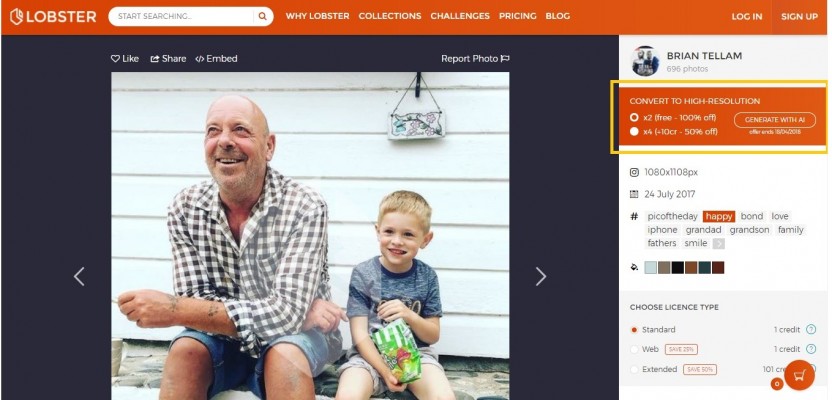London, 17th April 2018: Lobster announced today the release of its Super Resolution feature. Super Resolution provides up to four times the quality of Instagram sourced images (usually no bigger than 1080x1350 px). With the standard of imagery continually improving, those using Super Resolution now have access to sharp, clear images even when pictures are zoomed in at 100 percent.
Instagram’s lower-resolution is no longer an issue. Companies’ searching for authentic imagery from one of the most important social media platforms can now do so knowing they will get the highest quality.
The principal focus is on providing brands with the freedom to opt for an Instagram item at ultra-high definition, which they can use in marketing campaigns, both in digital and print, without losing any of the picture quality.
Lobster head of R&D, Vladimir Pavlov, says, ”To solve the problem of increasing the resolution of images, we used convolutional neural networks. In one click, after a little waiting, our neural network will generate a new image with a higher resolution, ready for a diverse range of mediums including print and ”.
Super Resolution is free for all users signed up to Lobster until April 18th. It will then become a paid feature.
Style Transfer
In addition to Super Resolution images, Lobster is launching Style Transfer, which provides companies with an extra layer of control over their branding. Style Transfer works similarly to popular apps like Prisma but is accessible from within the Lobster website.
Users have several different options to change the style of a purchased image. The result sees licensors with the ability to change the colour tone of each image acquired. They can also adapt the style of picture, creating a different atmosphere, mood and vibrancy of each image.
Taking the process further, brands can upload their company colours, which are then implemented straight into the images. This allows companies to develop purchased images with their own mood boards, by transferring their colours and style straight into the visuals.
Speaking about the Style Transfer options, Vladimir says, “The style transfer uses neural networks. An important feature is the ability to use your own style and it only takes two steps. The first is to upload the reference image, while the second is choosing and applying the loaded style to the image picked from the search.”
Smart Filter
Rounding off the announcement of new features is the Smart Filter. Lobster’s well-received Filters’ has been improved upon with the use of machine learning. When a user is searching for an image, they can turn on smart features to optimise picture results.
The new feature will help reduce the time users spend on filter settings and provided specific search results. Once a search term is entered, the Smart Filter searches the most suitable content based on the keyword.
An example is someone searching for the word “dad”. The Smart Filter decides that a dad is likely to be a single male of any ethnicity and aged from their 20s and up. The Smart Filters also make suggestions based on your previous search results.
Improving user experience
Each new feature is designed to enhance the overall Lobster experiences and provide a commitment to the highest quality of imagery. They also integrate well with Lobster’s last Style Matcher updates.
Lobster CEO, Olga Egorsheva, welcomes these new additions, saying, “Lobster is dedicated to creating a hub for user-generated content that provides companies with high-level results.
“From the Super Resolution that allows brands to achieve the highest quality of image output, to the Style Transfer, which creates new layers for photos, and Smart Filters, which gives companies the option of getting their results faster.
“Each feature is designed with visual output and efficiency in mind.”
About Lobster
Companies are finding smarter ways to work thanks to the growing presence of artificial intelligence in the mainstream.
Lobster, an AI-powered marketplace for user-generated content, plays a key role in helping creatives, brands, and media agencies license high-quality content directly from social media.
The company uses algorithmic engineering and machine learning for its image recognition software. This software, combined with social media metadata, allows the artificial intelligence (AI) to find high quality and relevant content from a pool of seven billion different pieces of content.
Businesses legally license images and videos from creators, with 75 percent of the revenue going to the content owner. If needed, Lobster also reaches out to individual image owners and negotiates directly.
Clients include Google, Seven Eleven and several well-known agencies, including Oliver Wyman.



